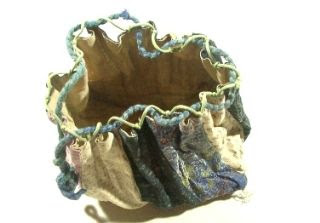Rather than trying to do a huge recap, I'll just jump in where I'm at now.
I have been thinking about the idea of a temperature quilt in sashiko ever since once of my former Stockton sashiko students mentioned it. Today, I added a fabric pack to my website's 'Twelve Days of Christmas' special sales event that I've put together for a sashiko temperature quilt. Since I was sorting out fabrics for myself, I figured I might as well do packs for sale!
I chose twelve Kofu Tsumugi fat quarters shading through from cool blues to warm reds and purples, via greens and yellow, to make my version of a 'temperature quilt' in sashiko - using one 3 1/2in square per day, the fabric representing the daytime high temperature, and the sashiko thread shading in colours to represent the night time low temperature. Using one fabric colour for three degrees, there are enough colours to allow for a variation of 36ºC, but if you live in a place with less variation, like I do, you could use one colour per 2ºC increment instead. More about that in a moment!
How do you work out the colours for a temperature quilt? You could record the daily high and low temperature yourself (that's the most work!), or take the information from online weather forecast sites like accuweather.com which has historical temperature records for many locations worldwide. temperature-blanket.com is very helpful, including more links to historical temperature records but also having visualisation tools where you can choose colours (from knitting yarn swatches), temperature increments, and a blanket/quilt generator so you can get an impression of how your quilt is going to look. Of course, if you think the temperature range where you live isn't very dramatic (ours isn't!), you can always use a different location. I'm planning to make mine using the temperatures from Shōnai, Japan, where I used to live, which is warmer in summer than Perthshire, but slightly colder in winter.
Colours I chose are (cold to hot) - deep blue purple 2508, indigo blue 2008, teal blue 2507, light blue (slate blue) 2506, dark green 2004, green 2505, light grey (taupe) 2501, mustard yellow 2007, russet 2503, brick red 2002, deep red 2003, and bright purple 2513. Depending on the temperature variation where you live, you may need a little extra of some colours.
If you live somewhere with a very wide variation in daytime temperatures or you want to use one fabric per 2ºC increment, you could extend the number of fabrics with a second 'extender' assortment, with various greys and a softer pink and lilac. Since Olympus brought out the new shades in the Kofu Tsumugi range last year, it is possible to have enough shades to do this.
Kofu Tsumugi is a richly coloured yarn dyed tsumugi cotton fabric from Olympus Thread Mfg. Co., good for sashiko, patchwork, bag making and other projects. It is the same fabric used for my pre printed sashiko panels. The coloured warp and black weft gives this fabric a deep colour, with little slubs to add texture and character. The weave is loose enough to easily stitch sashiko with fine or medium sashiko threads but close enough to be able to do quite fine patchwork piecing. Ideal for wearables, furoshiki wrapping cloths etc. I've used it again and again. It was the fabric I used for the kasuri and sashiko kamon crest sampler I made for Japanese Quilt Blocks to Mix and Match over 15 years ago, which shows it is good for fine piecing as well as for sashiko.
Next, which blocks to choose? I wanted fairly simple ones. I don't think there's much chance of me stitching one block per day, and I'll probably be doing them in batches, but I liked the idea of cycling through seven different designs - one for each day of the week. I wanted simple designs that would work nicely on the smaller 3 1/2in square format, but still look like there was enough variety to give interest. I'll probably mix them up a bit more, so I don't have two squares next to each other for example, but these are the seven I've chosen (photos edited from my blocks for Sashiko 365).
To make the maths easy and have the designs fit nicely, I am using a mixture of imperial and metric for the marking.
1) On a 1cm grid -
2) On a 1.5cm grid (this is a quarter of the original design over 8cm, so each section will end up with three stitches rather than 2).
Other than the changes to grid and circle stize, I will be stitching these the same as in Sashiko 365, but I will be using medium sashiko thread to get the colour range I want for the shading. Planned colours are 100m sashiko thread in #112 turquoise, #108 light blue, #101 antique white, #115 creamy white, #102 cream, #106 yellow ochre, #111 golden yellow. Between #102 and #106, I'll include #A7 mellow yellow. #A4 baby blue might also make a good transition between #101 and #112.
I will try to post some photos once I have a few squares stitched.



















































